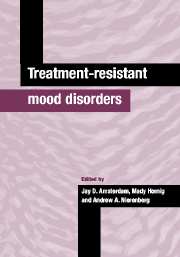Book contents
- Frontmatter
- Contents
- List of contributors
- Preface
- Part I The clinical problem
- Part II Biological basis
- Part III Treatment approaches
- 8 Selective serotonin reuptake inhibitors and serotonin–norepinephrine reuptake inhibitors in treatment-resistant depression
- 9 Conventional and second generation monoamine oxidase inhibitors in treatment-resistant depression
- 10 Drug combination strategies
- 11 Electroconvulsive therapy in medication-resistant depression
- 12 Thyroid augmentation
- 13 Cognitive therapy and psychosocial interventions in chronic and treatmentresistant mood disorders
- Part IV Special patient populations
- Part V Economic and ethical issues
- Index
- Plate Section
11 - Electroconvulsive therapy in medication-resistant depression
from Part III - Treatment approaches
Published online by Cambridge University Press: 25 March 2010
- Frontmatter
- Contents
- List of contributors
- Preface
- Part I The clinical problem
- Part II Biological basis
- Part III Treatment approaches
- 8 Selective serotonin reuptake inhibitors and serotonin–norepinephrine reuptake inhibitors in treatment-resistant depression
- 9 Conventional and second generation monoamine oxidase inhibitors in treatment-resistant depression
- 10 Drug combination strategies
- 11 Electroconvulsive therapy in medication-resistant depression
- 12 Thyroid augmentation
- 13 Cognitive therapy and psychosocial interventions in chronic and treatmentresistant mood disorders
- Part IV Special patient populations
- Part V Economic and ethical issues
- Index
- Plate Section
Summary
Introduction
Electroconvulsive therapy (ECT) is an effective treatment for major depressive disorders. It is usually reserved for patients who are so ill as to require hospital care. In direct comparisons between ECT and either tricyclic antidepressant drugs (TCA) or monoamine oxidase inhibitors (MAOI), ECT is more effective than either. (We lack information as to the relative efficacy of SSRI and ECT as such studies have not been done.)
The antidepressant efficacy of ECT is well established even in patients who have failed prior adequate courses of TCA and MAOI (Abrams, 1997; Avery & Lubrano, 1979; Fink 1979, 1999; Kantor & Glassman, 1977). In patients with delusional depression, TCA alone are approximately 35% effective while ECT elicits a robust response evaluated as 80% effective, equal to that reported for the combination of high doses of TCA and neuroleptic drugs (Kroessler et al., 1985; Parker et al., 1992). Despite its efficacy, and even superiority, in relieving severe depressive disorders, ECT is infrequently used. In modern guidelines and algorithms, it is almost always considered a treatment of last resort, if it is considered at all.
Many pundits have remarked that, were its merits available in capsule form, ECT would occupy a central role in treating major depressive disorders. Many reasons are given for the discrepancy between the experimental data and its present usage, and of these, three seem the most cogent.
ECT is a technical science that requires special facilities and special skills. Additional training and qualification is required of the psychiatrist. Unfortunately, training in ECT is rarely a feature of medical school experience and is unavailable in most psychiatric residency training programs (Lehrmann, 2000).
Keywords
- Type
- Chapter
- Information
- Treatment-Resistant Mood Disorders , pp. 223 - 238Publisher: Cambridge University PressPrint publication year: 2001
- 3
- Cited by



